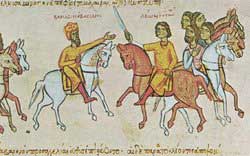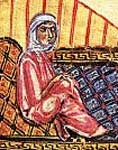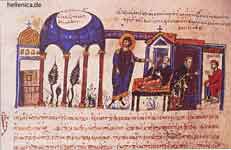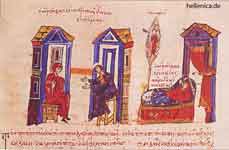.
![]()
Basil, his son Constantine, and his second wife, emperess Eudoxia Ingerina. [Source]
Basil I, called the Macedonian (Greek: Βασίλειος Α΄ο Μακεδών, Basileios I o Makedhon), (c. 811 – August 29, 886) was a Byzantine emperor. He was perceived by Byzantines as one of their greatest emperors, the founder of the most splendid imperial dynasty of Byzantium, the Makedonoi, and the initiator of a renaissance of Byzantine art. However, the opinion of modern historians is less flattering as it appears that reforms associated with his name were in reality launched by his predecessor, Michael III, whom Basil had assassinated.
From peasant to emperor
Basil I's ethnic origin has been a source of numerous controversies ever since his lifetime. According to tradition current in his own reign, Basil was of Armenian descent and supposedly a distant descendant of an Armenian princely family. His parents were probably Armenian peasants who had been settled in the Byzantine theme of Macedonia (an administrative division corresponding to the area of Adrianople in Thrace) according to standard Byzantine practice.
He spent a part of his childhood in captivity in Bulgaria, where his family had been carried off as captives of Krum of Bulgaria since 813. Together with much of the resettled captive population, Basil succeeded in escaping in c. 836 and was ultimately lucky enough to enter the service of Theophilitzes, a relative of the Caesar Bardas (the uncle of Emperor Michael III), as groom.
While serving Theophilitzes, he visited the city of Patras, where he gained the favour of Danielis, a wealthy woman who took him into her household and endowed him with a fortune. He also earned the notice of Michael III by winning a victory over a Bulgarian champion in a wrestling match, and soon became the emperor's companion and bodyguard (parakoimomenos).
On Michael's orders, he divorced his wife Maria and married Eudokia Ingerina, Michael's favorite mistress, in c. 865. It was commonly believed that Leo VI, Basil's successor and reputed son, was really the son of Michael. Although Basil seems to have shared this belief, the subsequent promotion of Basil to Caesar and then co-emperor provided the child with a legitimate and imperial parent and secured his succession to the throne.
During an expedition against the Arabs, Basil convinced Michael III that his uncle Bardas coveted the throne, and murdered Bardas with Michael's approval on April 21, 866. Now Basil became the leading personality at court and was invested in the now vacant dignity of kaisar (Caesar), before being crowned co-emperor on May 26. This promotion may have included Basil's adoption by Michael III, himself a much younger man.
As Michael III started to favor another courtier, Basil decided that his position was being undermined and preempted events by organizing the assassination of Michael on the night of September 23/24, 867.
Reign

Basil I and his son Leo. [Source]
Basil I inaugurated a new age in the history of the empire, associated with the dynasty which he founded. This is called the Macedonian Dynasty. It was a period of territorial expansion, during which the empire was the strongest power in Europe.
To secure his family on the throne, Basil I associated as co-emperors his eldest son Constantine (in 869) and his second son Leo (in 870).
Because of the great legislative work which Basil undertook, and which may be described as a revival of the laws of Justinian I, he is often called the "second Justinian." Basil's laws were collected in the Basilica, consisting of sixty books, and smaller legal manuals known as the Prochiron and the Eisagoge. Leo VI was responsible for completing these legal works. Basil's financial administration was prudent.
His ecclesiastical policy was marked by good relations with Rome. One of his first acts was to exile the patriarch Photios and restore his rival Ignatios, whose claims were supported by Pope Adrian II. However, Basil had no intention of yielding to Rome beyond a certain point. The decision of Boris I of Bulgaria to align the new Bulgarian Church with Constantinople was a great blow to Rome, which had hoped to secure it for herself. But on the death of Ignatios in 877, Photios became patriarch again, and there was a virtual, though not a formal, breach with Rome. This was a watershed event in conflicts that led to the Great Schism that ultimately produced the Roman Catholic Church and the Eastern Orthodox Church as separate entities.
Basil's reign was marked by the troublesome ongoing war with the Paulicians, centered on Tephrike on the upper Euphrates, who rebelled, allied with the Arabs, and raided as far as Nicaea, sacking Ephesus. Basil's general Christopher defeated the Paulicians in 872, and the death of their leader Chrysocheir led to the definite subjection of their state. There was the usual frontier warfare with the Arabs in Asia Minor, which led to little concrete gain, but Byzantium's eastern frontier was strengthened. The island of Cyprus was recovered, but retained for only seven years.
In the West, Basil allied with Louis II, Holy Roman Emperor against the Arabs and his fleet cleared the Adriatic Sea from their raids. With Byzantine help, Louis II captured Bari from the Arabs in 871. The city eventually became Byzantine territory in 876. However, the Byzantine position on Sicily deteriorated, and Syracuse fell to the Emirate of Sicily in 878. Although most of Sicily was lost, the general Nikephoros Phokas (the Elder) succeeded in taking Taranto and much of Calabria in 880. The successes in the Italian Peninsula opened a new period of Byzantine domination there. Above all, the Byzantines were beginning to establish a strong presence in the Mediterranean Sea, and especially the Adriatic.
Basil's spirits declined in 879, when his eldest and favorite son Constantine died. Basil now associated as co-emperor his youngest son Alexander. Basil got on badly with Leo, whom he probably suspected of being the son of Michael III. Basil died on August 29, 886 from a fever contracted after a serious hunting accident when his belt was caught in the antlers of a deer, and he was dragged from his horse. He was saved by an attendant who cut him loose with a knife, but he suspected the attendant of trying to assassinate him and had the man executed shortly before he himself died.
Family
By his first wife Maria, Basil I had several children, including:
- Symbatios, renamed Constantine, co-emperor from 869 to 879.
- Anastasia, who married the general Christopher.
By his second wife, Eudokia Ingerina, Basil I officially had three sons:
- Leo VI, who succeeded as emperor and may actually have been the son of Michael III.
- Stephen I, patriarch of Constantinople, who may also have been a son of Michael III.
- Alexander, who succeeded as emperor in 912.
Byzantine Emperor
Preceded by: Michael III
Succeeded by: Leo VI
References
- The Oxford Dictionary of Byzantium, Oxford University Press, 1991.
- Cyril Mango, "Eudocia Ingerina, the Normans, and the Macedonian Dynasty," Zbornik radova Vizantoloskog Instituta, XIV-XV, 1973, 17-27.
- This article incorporates text from the 1911 Encyclopædia Britannica, which is in the public domain.
| Ancient Greece
Science, Technology , Medicine , Warfare, , Biographies , Life , Cities/Places/Maps , Arts , Literature , Philosophy ,Olympics, Mythology , History , Images Medieval Greece / Byzantine Empire Science, Technology, Arts, , Warfare , Literature, Biographies, Icons, History Modern Greece Cities, Islands, Regions, Fauna/Flora ,Biographies , History , Warfare, Science/Technology, Literature, Music , Arts , Film/Actors , Sport , Fashion --- |
Retrieved from "http://en.wikipedia.org"
All text is available under the terms of the GNU Free Documentation License




